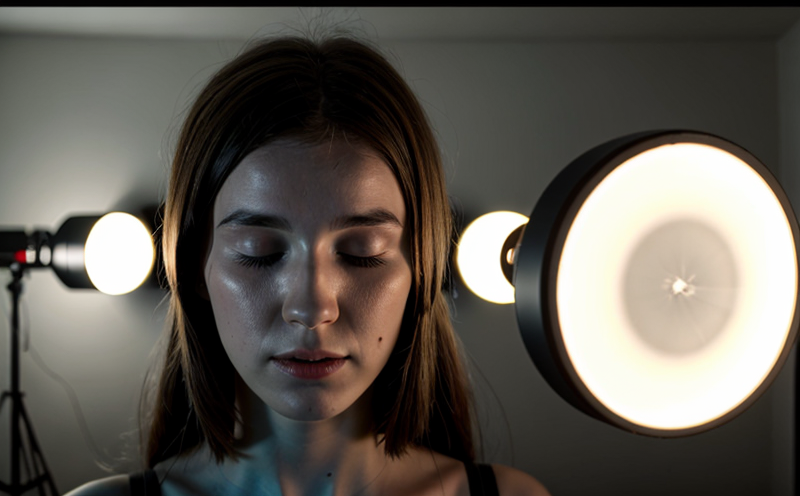ISO CIE 212 Flicker Perception Testing of Indoor Lighting
The ISO/IEC 212:2013 standard provides a method to evaluate flicker in indoor lighting systems. This test is crucial for ensuring that artificial light sources do not cause discomfort, visual strain, or health issues due to excessive flicker. Flicker can be caused by various factors such as the type of lamp, ballast design, and power supply frequency. When a light source produces flicker, it means there are variations in brightness over time. These variations can affect human perception differently depending on their duration, intensity, and frequency.
The standard defines two main types of flicker: perceptible flicker and stroboscopic effect. Perceptible flicker is the most common type where the observer can consciously detect changes in brightness. The ISO/IEC 212 method measures this by calculating the perceived flicker index (PFI). This value helps determine whether the flicker level is acceptable for human perception, typically set at a threshold below which no discomfort or visual strain should occur.
The test procedure involves measuring the light intensity and frequency of fluctuations over time. Instruments such as photometers equipped with specialized sensors are used to capture these variations accurately. The data collected then undergoes statistical analysis according to the ISO/IEC 212 guidelines to calculate the PFI.
Understanding flicker perception is particularly important in environments where prolonged exposure to lighting fixtures occurs, like offices, hospitals, and educational institutions. In these settings, even small amounts of flicker can lead to reduced productivity, discomfort, or even safety concerns if it affects visual tasks such as reading or driving.
The ISO/IEC 212 method ensures compliance with international standards, enhancing product quality and customer satisfaction by eliminating potential health hazards associated with excessive flicker. Compliance with this standard also opens up opportunities for market access in regions where stringent lighting regulations are enforced.
For R&D engineers working on new lighting designs or modifications to existing ones, understanding the flicker perception test is essential. It allows them to optimize their products' performance, ensuring they meet both safety and comfort requirements. Quality managers responsible for maintaining high standards across production processes will find this testing indispensable in preventing non-compliance issues that could lead to costly recalls.
In summary, ISO/IEC 212 flicker perception testing plays a vital role in safeguarding public health while improving the overall user experience of indoor lighting systems. By adhering to these stringent tests and ensuring compliance with international standards, manufacturers can enhance their reputation, meet regulatory requirements, and ultimately deliver superior products.
Why Choose This Test
Selecting ISO/IEC 212 flicker perception testing for your indoor lighting projects offers several advantages:
- Avoids Health Risks: Ensures that your lighting products do not emit harmful levels of flicker, which can cause eye strain and other health issues.
- Meets Regulatory Requirements: Helps in meeting international standards, thereby facilitating easier market entry into countries with strict lighting regulations.
- Enhances Product Quality: Provides detailed insights into the performance characteristics of your light sources, allowing for continuous improvement and optimization.
- Promotes Customer Satisfaction: By ensuring a comfortable and safe environment for users, you enhance customer satisfaction and loyalty.
- Supports Innovation: Allows R&D teams to innovate while adhering to stringent quality control measures.
- Cost Efficiency: Early detection of flicker issues through this testing process can prevent costly reworks or product recalls later in the production cycle.
These benefits make ISO/IEC 212 flicker perception testing an indispensable tool for any company involved in the design, manufacturing, and sale of indoor lighting solutions.
Customer Impact and Satisfaction
The impact of choosing ISO/IEC 212 flicker perception testing extends beyond mere compliance with international standards. It directly influences customer satisfaction by delivering a more comfortable and safer lighting experience:
- Better Visual Comfort: By eliminating or reducing perceptible flicker, you ensure that your customers can enjoy their lighting without experiencing any discomfort.
- Increased Safety: In critical environments such as hospitals or airports, flicker-free lighting is essential for maintaining safety and efficiency.
- Enhanced Product Reputation: Customers are more likely to trust brands that demonstrate a commitment to high-quality standards like ISO/IEC 212.
- Positive Environmental Impact: Comfortable, safe, and efficient lighting systems contribute positively to the environment by reducing energy consumption associated with unnecessary adjustments or replacements due to flicker issues.
In conclusion, incorporating ISO/IEC 212 flicker perception testing into your quality assurance process not only meets regulatory requirements but also enhances customer satisfaction and product reputation.
Use Cases and Application Examples
The application of ISO/IEC 212 flicker perception testing is broad, covering various sectors where indoor lighting plays a crucial role:
- Offices: Ensuring that the ambient lighting does not cause discomfort to employees during long working hours.
- Hospitals: Maintaining stable and comfortable lighting conditions in patient care areas to enhance healing environments.
- Schools: Providing a distraction-free learning environment for students by eliminating flicker that could interfere with visual tasks.
- Airports: Enhancing safety and efficiency by maintaining consistent illumination levels, especially during critical operations like runway lighting.
In each of these use cases, the goal is to ensure that indoor lighting systems are not only functional but also contribute positively to the well-being of those who interact with them daily. By adhering to ISO/IEC 212 standards, manufacturers can achieve this objective effectively.





